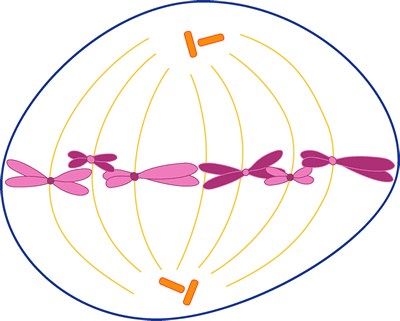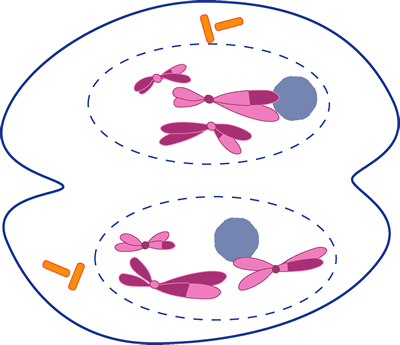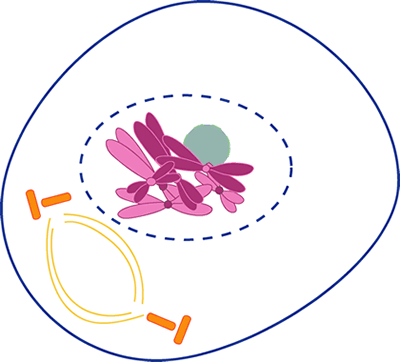Web Lesson: Cloning in Focus
Genetic Science Learning Center
http://gslc.genetics.utah.edu/units/cloning/
http://learn.genetics.utah.edu/content/tech/cloning/
Open the link and view each of the sections under "Cloning in Focus". For each section, answer the question.
What is Cloning?
1. Who is Dolly?
1A. Dolly is the first ever mammal to be cloned using a somatic cell from an adult. She was created using SCNT (Somatic Cell Nucleic Transfer).
2. When a zygote divides into two separate cells, it is called:
2A. (Natural) Twinning
3. Somatic cells are also called:
3A. Diploid cells
4. In order to clone a gene, a gene is inserted into a:
4A. Plasmid
5. In order to create an embryo from a somatic cell, the donor egg cell must have its ___________________ removed.
5A. Nucleus
Click and Clone
6. List all the materials needed to clone a mouse.
6A. In order to clone a mouse you need a mouse to clone, an egg cell donor, a surrogate mother (to raise the mouse clone), petri dishes, a microscope, a sharp and blunt pipette, and a chemical to activate cell division.
7. Place the following steps in the correct order.
7A. 1 Isolate donor cells from egg donor and germ cell donor
2 Remove and discard the nucleus from the egg cell
3 Transfer the somatic cell nucleus into the egg cell
4 Stimulate cell division
5 Implant embryo into a surrogate mother
6 Deliver baby
8. There are two time gaps in the process of cloning. What are they? (ie. what do you have to wait for?)
8A. You have to wait for the DNA and egg cell to adjust (the DNA needs to "reboot") and the cells to divide.
9. What color would the cloned mouse be? What is the name of this mouse?
9A. The cloned mouse would be the color of the mouse it received its genetic material from, in this case the mouse is cloning Mimi the brown mouse so the clone is brown. The clone of Mimi is Mini-Mimi.
Why Clone?
10. Why is cloning extinct animals problematic?
10A. Cloning extinct animals is problematic due to the lack of well-preserved DNA. Also, even if an extinct species' DNA was preserved, it would not be able to be raised because it would need a surrogate mother, which is ideally similar or related to the extinct species. Thus it is near impossible to clone a long-extinct species such as a dinosaur. An animal more recently extinct might have a chance at being cloned, but then it may be very susceptible to a disease or bacteria.
11. What are some reasons a person might want to clone a human?
11A. A person may want to clone a loved one who died, like a relative or friend. Also, a person may want to clone themselves so that they may have someone to carry out their life's work.
The Clone Zone
12. What animal was cloned in 1885?
12A. A sea urchin
13. How did Spemann separate the two cells of the embryo of a salamander in 1902?
13A. Spemann created a miniature noose with a baby's hair and used it to cleave the embryo into two.
14. The process of removing a nucleus is called:
14A. Enucleation
15. In 1952, the nucleus of a ____________ embryo cell was placed into a donor cell. Did it work to clone the animal? ____________
15A. Frog, the animal was cloned, but grew abnormally so it worked but was not successful.
16. Can the nucleus of an adult cell be injected into an egg cell and produce a clone? ___________
16A. Yes
17. Why are mammals hard to clone?
17A. Mammals are difficult to clone because they have smaller egg cells that are difficult to control and use.
18. What were the names of the first two cloned cows?
18A. Fusion and Copy.
19. In what year was the National Bioethics Advisory Council formed?
19A. 1995
20. The first mammal clone to be produced from an adult (somatic) cell?
20A. Dolly the sheep.
21. What do scientists do to adult cells to make them "behave" like embryos?
21A. Scientists reboot the adult cells by giving them an electric shock.
22. Transgenic, cloned sheep were used to produce what medical protein?
22A. Factor Nine, a protein to clot blood.
23. What is a stem cell?
23A. A stem cell is a cell that can divide indefinitely.
Cloning Myths
24. Briefly describe in your own words, why CC the cat was not identical in color to Rainbow, even though she was a clone?
24A. CC the cat was a clone, but did not have the color that Rainbow did because when Rainbow was developing, a process called X-inactivation that randomly 'shuts down' cells on the X chromosome. Cats have a gene on the X chromosome that decides the color of the cat. Both Rainbow and CC have two of these genes that code for an orange and black coat. But due to the turnning off of one whole X chromosome, Rainbow had a motley cells, some coded for orange and some black and then some white. Thus Rainbow's patchwork coat. CC did not go through the X-inactivation process, and so did not have Rainbow's colorful palet, but rather a black and white coat. Therefore, clones do not necessarily come out identical.
25. What is "nature vs nurture"?
25A. Nature vs Nurture is whether a person is what they are and does what they do due to their genes and nature or because of their experiences and environments.
Is it Cloning or Not?
26. For each of the following scenarios, indicate YES (it is cloning) or NO (it is not cloning)
No. Sperm taken from a male goat is combined with a female's egg in a petri dish. The resulting embryo is implanted into the female's uterus to develop
Yes. A sheep embryo, composed of 16 cells, is removed from the mother's uterus and separated into indivudal cells. Each cell is allowed to multiply, creating 16 separate embryos, which are then implanted in different female sheep to develop to maturity.
Yes. A cow with many desirable traits is stimulated with hormones to produce a number of egg cells. Each of these eggs is fertilized and implanted into a surrogate mother.
No. In vitro fertilization
Yes. Cell nuclei from an extinct wolly mammoth are placed into enucleated cow cells.
27. Define or describe each of the following processes (you may need to reset the Cloning or Not Screen)
Invitro fertilization: The fusing of a sperm and egg that results in offspring not identical to mother or father.
Embryo splitting: The splitting of embryos into multiple embryos with same genetic makeup.
Somatic Cell Nuclear Transfer: The process used to clone an organism by collecting cells to transfer the nucleus into an enucleated egg.
Multiple Ovulation Embryo Transfer: The process in which multiple (unidentical) egg cells are produced from a wanted animal and fertilized.
Artificial Insemination: When a germ cell from a desirable animal is used to get certain traits through selective breeding.
What Are the Risks of Cloning?
28. What is one reason why cloning animals has such a high failure rate?
28A. One reason why cloning animals has a high failure rate is because often the embryo does not implant well into the surrogate mother.
29. What is a telomere and how does it affect cloned animals?
29A. A telomere is what allows cells to have DNA after a lot of cell division. A telomere is located towards the end of DNA strands. Telomeres keep a DNA strand from shrinking. Telomeres affect cloned animals by making their life span longer or shorter.
What Are Some Issues in Cloning?
30. Pick one of the questions to ponder and ....ponder it. Write a brief essay on your thoughts and opinions.
30A. If a clone originates from an existing person, who is the parent?



 This is metaphase because the chromosomes are all aligned.
This is metaphase because the chromosomes are all aligned. This stage is Cytokinesis because the daughter cells are being cleaved.
This stage is Cytokinesis because the daughter cells are being cleaved. This stage is Prophase because the mitotic spindles are forming.
This stage is Prophase because the mitotic spindles are forming.